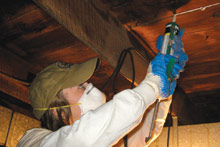In the alternate universe of the graphic novel (and new movie) Watchmen, angst-ridden heroes clad in tights, capes and masks fret about the state of humanity and their place in a sinister world. Warren Wilson College’s young weatherization heroes evince no such sentiments, though they do sport safety masks and loads of can-do spirit. During spring break, they’ve set the ambitious goal of weatherizing five homes in five days.

It’s all part of the INSULATE! program, which aims to help those area residents who need it most, student coordinator Ian Higgins explains. He cites the case of an 84-year-old woman who was spending about a third of her $10,000-a-year income on energy bills. People in her position must often choose between buying food and medicine or heating and cooling their homes, notes Higgins. In Buncombe County alone, about 44,000 households have incomes significantly below the national poverty level, he says.
Through INSULATE!‘s efforts, he calculates, the elderly woman’s energy bills have been cut by about 20 percent—and her home’s annual carbon-dioxide emissions by about 2 tons per year. Replicating such efforts nationwide could reduce CO2 emissions 80 percent by the year 2030, Higgins maintains.
That goal may not be out of reach. The Warren Wilson program, launched last year, is part of a national effort involving college students, organizations, volunteers and professionals across the country, says Phillip Gibson, community-outreach director for the college’s Environmental Leadership Center.
In 2007, Warren Wilson students attended the first Power Shift conference, sponsored by the nationwide Energy Action Coalition. The conference, says Gibson, called on the nation’s young people to take action. And coming from a school that’s always emphasized volunteerism and work projects, the Warren Wilson students were inspired to create INSULATE!, bringing together the city of Asheville, Community Action Opportunities and the National Climatic Data Center, among other players.
A city crew will film much of the work and post it on Asheville’s Web site as how-to videos for weather-stripping, vapor-barrier installation, caulking and other techniques. The Data Center will collect before-and-after information and serve as a data repository for similar projects around the country. Community Action Opportunities helps identify those in need through its weatherization-assistance program. And local professionals provide the training and on-site assistance that helps the students get it all done, Gibson explains.
Call it the power of networking.
At this year’s Power Shift conference, Warren Wilson students gave a presentation about INSULATE!, consulted with students doing similar projects, and met with a member of U.S. Rep. Heath Shuler‘s staff. Shuler may present INSULATE! to his House colleagues as a model for meeting President Obama’s goal of weatherizing 1 million homes per year; the congressman also hopes to join an INSULATE! crew during one of its workdays.
“This is a national movement, not just a spring-break project,” Gibson proclaims.
Teamwork
Local INSULATE! partners include Appalachian Offsets (funded by the WNC Green Building Council), the Asheville Home Builders Association, the city of Asheville, Blue Ridge Food Ventures (which feeds the student crews), TS Designs (which provides the shirts), Pisgah Valley Retirement Community (donations and staff volunteers), the Environmental Leadership Center, students from other schools (such as UNCA, UNC-Chapel Hill and Appalachian State), J.B. Adams Jr. and Associates (donations), Theros Olive Oil, Logan Turnpike Mill (food donations) and others.
Nonetheless, it happens one house at a time. With equipment funded by Progress Energy, Community Action Opportunities staff perform an energy audit on each home, identifying problem spots such as a poorly insulated attic or drafty windows, Higgins explains. Then a student crew—wearing donated organic-cotton T-shirts and safety masks—gets to work, crawling into attics and basements to install vapor barriers, caulk gaps and mark where foam insulation is needed.
“Sometimes we find housing-code violations, such as a stove vent that wasn’t working, and we fix it,” notes Higgins.
In another project, students dug a 20-foot-long, 2-feet-deep trench for a French drain to keep water away from the resident’s basement. (Ironically, sealing up a home to improve energy efficiency can make interior air quality more vulnerable to the effects of a moldy basement.)
And with thousands more homes to do, they’re looking for help. As Higgins says, “We want to have an army of people who can roll up their sleeves and go to work.”
Check out the project’s student blog at http://insulatenc.blogspot.com/. For more information, contact Phillip Gibson (712-0972; e-mail: pgibson@warren-wilson.edu).
Send your environmental news to mvwilliams@mountainx.com, or leave a message at 251-1333, ext. 152.



What an awesome way to make a difference.